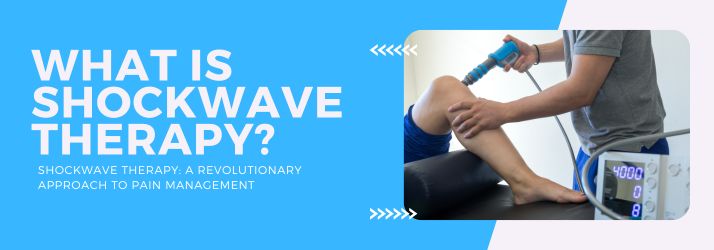What is Shockwave Therapy?

Finding non-invasive and effective treatments is a top priority for healthcare professionals and patients alike. One such innovative treatment option is shockwave therapy, a non-surgical intervention that has gained significant popularity in recent years. Used to treat various musculoskeletal conditions, shockwave therapy provides a promising alternative to traditional pain management strategies. In this article, we will delve into what shockwave therapy is, how it works, and the conditions it can help treat.
What is Shockwave Therapy?
Shockwave therapy, also known as extracorporeal shock wave therapy (ESWT), is a non-invasive treatment that utilizes high-energy acoustic waves to target and stimulate the body's natural healing processes. The therapy involves the use of a specialized device that generates shockwaves, which are then transmitted through the skin and into the affected tissues. Shockwave therapy has been employed in various medical fields, such as urology and orthopedics, and has recently gained attention in pain management due to its potential to alleviate discomfort and promote healing.
How Shockwave Therapy Works
Shockwave therapy works by delivering targeted, high-energy acoustic waves to the affected tissues. The therapy's precise mechanism of action is not yet fully understood; however, several theories suggest that it promotes healing through the following processes:
- Neovascularization: Shockwave therapy stimulates the formation of new blood vessels in the treated area, improving blood flow and oxygenation, which can promote healing and reduce inflammation.
- Cellular effects: The acoustic waves generated during shockwave therapy can induce various cellular responses, such as the release of growth factors and the activation of anti-inflammatory pathways. These cellular changes can contribute to tissue regeneration and healing.
- Breakdown of calcifications: In some cases, shockwave therapy can help break down calcifications in soft tissues, which can contribute to pain and reduced mobility.
- Pain modulation: Shockwave therapy may help modulate pain signals by stimulating nerve fibers and altering pain perception.
Conditions Treated with Shockwave Therapy
Shockwave therapy has been successfully used to treat various musculoskeletal conditions, including:
- Plantar fasciitis: This therapy has shown promising results in treating plantar fasciitis, a common cause of heel pain, by reducing inflammation and promoting tissue healing.
- Tennis elbow: Shockwave therapy has been employed to alleviate pain and inflammation associated with tennis elbow, a condition characterized by overuse and strain of the forearm muscles.
- Achilles tendinopathy: By stimulating blood flow and tissue regeneration, shockwave therapy can help treat Achilles tendinopathy, a condition that involves degeneration and inflammation of the Achilles tendon.
- Calcific tendinitis: Shockwave therapy has demonstrated effectiveness in treating calcific tendinitis by breaking down calcium deposits and promoting tissue healing.
- Patellar tendinopathy: Also known as jumper's knee, patellar tendinopathy is a condition that affects the patellar tendon. Shockwave therapy has shown promise in reducing pain and promoting tendon healing.
Benefits of Shockwave Therapy
Shockwave therapy offers several benefits as a pain management treatment option:
- Non-invasive: Unlike surgical interventions, shockwave therapy is non-invasive, reducing the risks and recovery time associated with more invasive procedures.
- Minimal side effects: Shockwave therapy is generally well-tolerated, with few reported side effects. Some patients may experience temporary discomfort, redness, or swelling at the treatment site.
- Short treatment duration: Individual shockwave therapy sessions typically last between 15 and 30 minutes, allowing for a relatively quick treatment option.
- No anesthesia required: Since shockwave therapy is non-invasive and well-tolerated, there is no need for anesthesia, making the treatment process more straightforward and less intimidating for patients.
- Long-lasting pain relief: Shockwave therapy has been shown to provide long-lasting pain relief for many patients, with some studies reporting improved outcomes even after one year following the treatment.
- Suitable for various conditions: As mentioned earlier, shockwave therapy has been successfully used to treat a range of musculoskeletal conditions, making it a versatile treatment option for pain management.
Shockwave therapy is a revolutionary, non-invasive treatment option in the pain management field that has shown promising results in treating various musculoskeletal conditions. By delivering targeted, high-energy acoustic waves to affected tissues, this therapy can stimulate healing, reduce inflammation, and modulate pain signals. With its numerous benefits, such as minimal side effects, short treatment duration, and long-lasting pain relief, shockwave therapy is a valuable addition to the repertoire of pain management strategies. If you are experiencing pain due to a musculoskeletal condition, consider consulting with a healthcare professional to determine if shockwave therapy is the right treatment option for your needs.
OFFICE HOURS
Monday
8:30am - 11:45am
12:30pm - 4:00pm
Tuesday
11:00am - 2:45pm
3:30pm - 7:00pm
Wednesday
11:00am - 2:45pm
3:30pm - 7:00pm
Thursday
11:00am - 2:45pm
3:30pm - 7:00pm
Friday
8:30am - 11:45am
12:30pm - 4:00pm
Saturday
8:30am - 11:45am
12:30pm - 4:00pm
Sunday
Closed
Reform Chiropractic
10345 Lakewood Blvd
Downey, CA 90241



